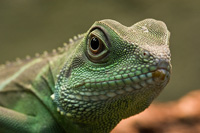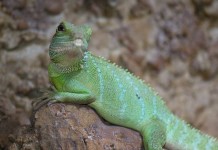Setting up an enclosure for your Chinese water dragon is an exciting task. You will try to include everything to make your pet’s new home look beautiful and appealing. Chinese water dragons are interesting reptiles as they can grow up to three feet in length. They have a friendly personality and do well if the new home is well-constructed and resembles their natural habitat.
Chinese water dragons have unique needs when it comes to heat, light and humidity. If you are thinking to get a water dragon, you need to have an enclosure that can maintain the ideal housing conditions required by your pet. Similar to other reptiles, the enclosure for a Chinese water dragon needs to be of adequate size.
You can choose to have a cage material of your choice, but the material you select should not harm your pet. Cages with wires help the dragons climb but can hurt the lizard’s snout. Glass, particularly plexiglass is a widely used cage material.
If you use an enclosure made of glass, you need to decorate it in a way that your pet does not bump into the walls. The fact is that the Chinese water dragon cannot identify glass. Your pet may try to get out or fight its own reflection which can damage its snout. Since water dragons are curious pets, it is better that you use artificial or live plants to create a barrier and prevent your pet from bumping into the glass walls. This also has the advantage that your pet can climb the plants and feel more at home.
 Enclosures made of wood are also popular among dragon owners. Wood has wonderful insulating properties and works well if you need to retain heat. A wooden enclosure is especially useful during the winter season. If you live in a cooler region, you should select an enclosure that has two to three sides made of wood. This will serve as a much better enclosure compared to one that is made using glass.
Enclosures made of wood are also popular among dragon owners. Wood has wonderful insulating properties and works well if you need to retain heat. A wooden enclosure is especially useful during the winter season. If you live in a cooler region, you should select an enclosure that has two to three sides made of wood. This will serve as a much better enclosure compared to one that is made using glass.
If you decide to build a customized enclosure for your pet, the material you use should be non-toxic. If you use plywood or other any wood in the enclosure, you need to waterproof it using polyurethane or coatings of latex paint. You need to be careful when you use waterproofing solutions and paint because they emit toxic fumes when you place a heat source nearby. It is important that you allow the solution to dry completely if you don’t want to hurt your new pet.










